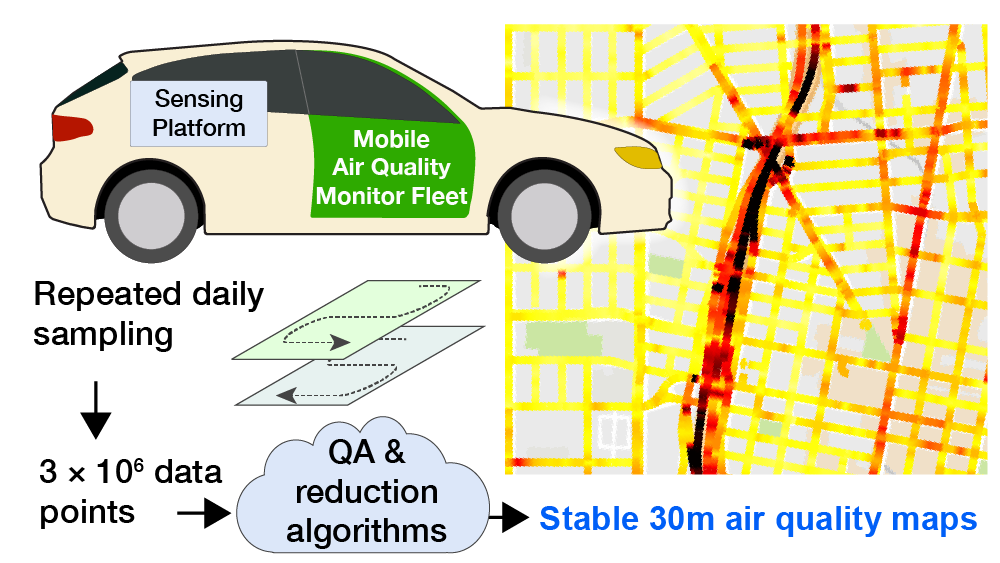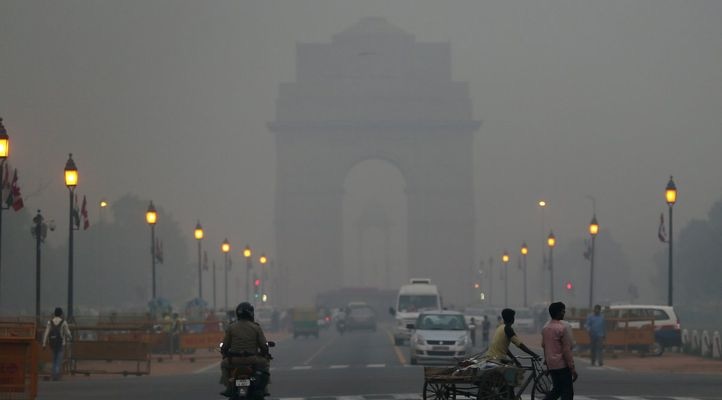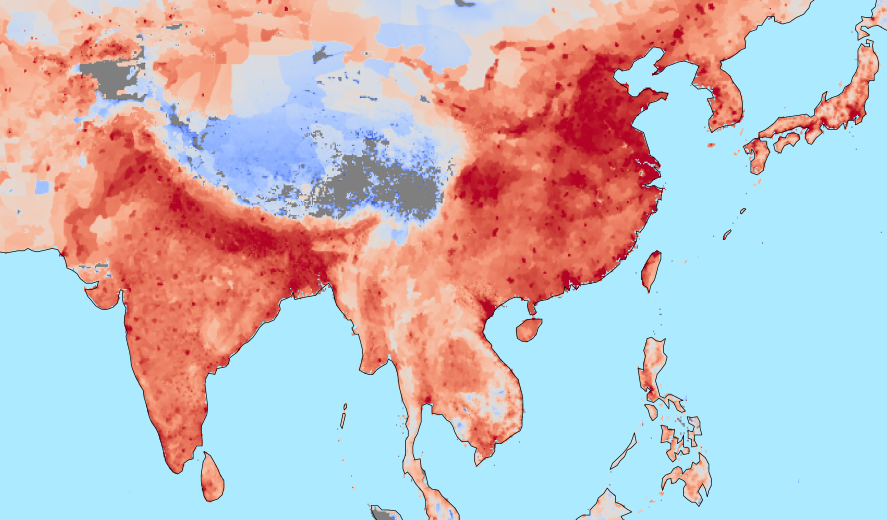

Please sign up for a single 15 min Zoom appointment.
Fall 2024: Tuesdays 12-1, 661 Davis Hall
Joshua Apte is an Associate Professor of Civil and Environmental Engineering at UC Berkeley. Apte’s research focus is air quality engineering and various techniques for air pollution exposure assessment. His research group uses field measurements, mathematical models, and analyses of large datasets to address policy-relevant air pollution challenges related to energy, infrastructure, climate change, and human health. Much of his research is motivated by a desire to identify technologies, policies, and strategies for improving the environmental sustainability of cities and the built environment and to reduce inequities in exposure to environmental contaminants in low-resource communities in the US and around the world.
ScB, Environmental Science, Brown University, 2004
M.S., Energy and Resources, UC Berkeley, 2008
Ph.D., Energy and Resources, UC Berkeley, 2013
ITRI-Rosenfeld Postdoctoral Fellow, Lawrence Berkeley National Lab, 2013-2014
Apte’s research focuses on the relationships between emissions, concentrations, exposure, and health effects to inform more effective strategies to reduce the impacts of built infrastructure on energy, air, climate, and health. His research group uses field and laboratory experiments, statistical and mathematical modeling, and data analysis to help develop the environmental sensing infrastructure of tomorrow and a rich understanding of where air pollution comes from, how it evolves, and who it impacts. Here are a few of the projects Apte is currently working on below:
 | Mapping air pollution with Google Street View cars In partnership with Google, Environmental Defense Fund, and Aclima, Apte’s research group maps urban air quality using specially equipped Google Street View cars. They have developed sampling strategies and data analysis algorithms to convert routine mobile air quality measurements into hyper-local maps of urban air quality at 30-meter resolution. |
 | Outdoor air pollution in South Asia Particle air pollution in South Asia - especially across the Indo-Gangetic basin in Northern India, Pakistan, Nepal, and Bangladesh - ranks among the most severe in the world. However, fundamental aspects of our understanding of particle air pollution in India are incomplete. Apte’s research group is investigating the emissions and physiochemical processes that affect PM concentrations and composition to help inform effective policies to reduce exposures and improve public health, with several studies focused on Delhi and Bangalore. |
 | Global health benefits of cleaner air Ambient particulate matter (PM2.5) is a major global risk factor for ill health and death. Apte’s research investigates the potential health benefits from improvements in global and regional air quality, addressing this important question: by how much would PM2.5 levels need to improve in order to substantially reduce mortality impacts? The scale of this challenge is strongly affected by the nonlinear relationship between air pollution and mortality. |
Selected Awards
- Google Faculty Research Award, 2020
Named to Grist 50 list of “the most exceptional people working for a sustainable world”, 2019
Best Paper of 2018 Award, Environmental Science & Technology Letters
Top Environmental Technology Article of 2017, Environmental Science & Technology
Walter A. Rosenblith New Investigator Award, Health Effects Institute, 2017
- ITRI-Rosenfeld Postdoctoral Fellowship, Lawrence Berkeley National Lab, 2013
Fulbright-Nehru Fellowship to India, US Department of State, 2010
At UC Berkeley, I teach courses in the School of Public Health and in the Department of Civil and Environmental Engineering.
Fall 2020: PH270A: Exposure Assessment and Control
Spring 2021: CE107: Climate Change Mitigation
In my prior appointment at the University of Texas at Austin, I taught the following courses in the Department of Civil, Architectural and Environmental Engineering.
CE377K/CE397 - Climate Change Mitigation [Fa15, Fa16, Fa17, Sp19, Sp20]
ARE377K - Energy Systems in the Built Environment [Sp20]
ARE370 - Design of Energy-Efficient and Healthy Buildings [Sp15, Sp16, Sp17]
CE397 - Aerosols, Air Quality, and Health [Sp17, Fa19]
LA329 - Global Learning Seminar: Addressing Air Pollution in the Developing World [Sp19]
Please see here for a list of current students in my research group.
Selected publications are presented below. My full publication list is provided here.
Lane HM, Morello-Frosch R, Marshall JD, Apte JS. 2022. Historical redlining is associated with present-day air pollution disparities in U.S. cities. Environmental Science & Technology Letters 9, 345-350. [open access]
Southerland VA, Brauer M, Mohegh A, Hammer M, van Donkelaar A, Martin RV, Apte JS, Anenberg SC. 2022. Global urban temporal trends in fine particulate matter (PM2.5) and attributable health burdens. Lancet Planetary Health 6, e139-e146. [open access]
Chambliss SE, Pinon CP, Messier KP, LaFranchi B, Upperman CR, Lunden MM, Robinson AL, Marshall JD, Apte JS. 2021. Local and regional-scale racial and ethnic disparities in air pollution determined by long-term mobile monitoring. Proceedings of the National Academy of Sciences 118, e2109249118. [open access]
Liang Y, Sengupta D, Campmier M, Lunderberg DM, Apte JS , Goldstein AH. 2021. Wildfire smoke impacts on indoor air quality assessed using crowdsourced data in California. Proceedings of the National Academy of Sciences 118, e2106478118. [link]
Tessum CW, Paolella DA, Chambliss SE, Apte JS, Hill JD, Marshall JD. 2021. PM2.5 polluters disproportionately and systemically affect people of color in the United States. Science Advances 18, eabf4491.
Bhandari S, Gani S, Patel K, Wang DS, Soni P, Arub Z, Habib G, Apte JS, Hildebrandt Ruiz L. 2020. Sources and atmospheric dynamics of organic aerosol in New Delhi, India: Insights from receptor modeling. Atmospheric Chemistry and Physics, 20, 735–752. [open access]
Apte JS and Pant P. Towards cleaner air for a billion Indians. 2019. Proceedings of the National Academy of Sciences 116, 10614-10616. [link]
Gani S, Bhandari S, Seraj S, Wang DS, Patel K, Soni P, Arub Z, Habib G, Hildebrandt Ruiz L, Apte JS. 2019. Submicron aerosol composition in the world’s most polluted megacity: The Delhi Aerosol Supersite study. Atmospheric Chemistry and Physics 19, 6843-6859. [open access]
Tessum CW, Apte JS, Goodkind AL, Muller NZ, Mullins KA, Paolella DA, Polasky S, Springer NP, Thakrar SK, Marshall JD, Hill JD. 2019. Inequity in consumption of goods and services widens racial-ethnic disparities in air pollution exposure. Proceedings of the National Academy of Sciences, 116, 6001-6006. [open access]
Messier KP, Chambliss SE, Gani S, Alvarez RA, Brauer M, Choi JJ, Hamburg SP, Kerckhoffs J, LaFranchi B, Lunden MM, Marshall JD, Portier CJ, Roy A, Szpiro AA, Vermeulen RCH, Apte JS. 2018. Mapping air pollution with Google Street View cars: Efficient approaches with mobile monitoring and land use regression. Environmental Science & Technology 52, 12563-12572. [open access]
Gu P, Li HZ, Ye Q, Robinson ES, Apte JS, Robinson AL, Presto AA. 2018. Intra-city variability of PM exposure is driven by carbonaceous sources and correlated with land use variables. Environmental Science & Technology, 52, 11545 - 11554. [link]
Burnett R, Chen H, Szyszkowicz M, Fann N, Hubbell B, Pope CA III, Apte JS, Brauer M, Cohen A, Weichenthal S, Coggins J, Di Q, Brunekreef B, Frostad J, Lim SS, Kan H, Walker KD, Thurston G, Hayes RB, Lim CC, Turner MC, Jerrett M, Krewski D, Gapstur SM, Diver WR, Ostro B, Goldberg D, Crouse DL, Martin RV, Peters P, Pinault L, Tjepkema M, van Donkelaar A, Villeneueve PJ, Miller, AB, Yin P, Zhou M, Wang L, Janssen NAH, Marra M, Atkinson RW, Tsang H, Thach TQ, Cannon JB, Allen RT, Hart J, Laden F, Cesaroni G, Forastiere F, Weinmayr G, Jaensch A, Nagel G, Concin H, Spadaro JV. 2018. Global estimates of mortality associated with long-term exposure to outdoor fine particulate matter. Proceedings of the National Academy of Sciences, 115, 9592-9597.[link open access]
Apte JS, Brauer M, Cohen AJ, Ezzati M, Pope CA III. 2018. Ambient PM2.5 reduces global and regional life expectancy. Environmental Science & Technology Letters 5, 546-551. [link]
Alexeef SE, Roy A, Shan J, Liu X, Messier K, Apte JS, Portier C, Sidney S, van den Eeden SK. 2018. High-resolution mapping of traffic related air pollution with Google Street View cars and incidence of cardiovascular events within neighborhoods in Oakland, CA. Environmental Health 17:38
Apte JS, Messier KP, Gani S, Brauer M, Kirchstetter TW, Lunden MM, Marshall JD, Portier CJ, Vermeulen RCH, Hamburg SP. 2017. High resolution air pollution mapping with Google Street View cars: Exploiting big data. Environmental Science & Technology51, 6999-7008. [link open access]
Apte JS, Marshall JD, Cohen AJ, Brauer M. 2015. Addressing global mortality from ambient PM2.5. Environmental Science & Technology 49, 8057-8066. [link open access]
Apte JS, Bombrun E, Marshall JD, Nazaroff WW, 2012. Global intraurban intake fractions for air pollutants from vehicles and other distributed sources. Environmental Science & Technology 46, 3415-3423. [link]
Apte JS, Kirchstetter TW, Reich AH, Deshpande SJ, Kaushik G, Chel A, Marshall JD, Nazaroff WW. 2011. Concentrations of fine, ultrafine, and black carbon particles in auto-rickshaws in New Delhi, India. Atmospheric Environment 45, 4470-4480. [link]
